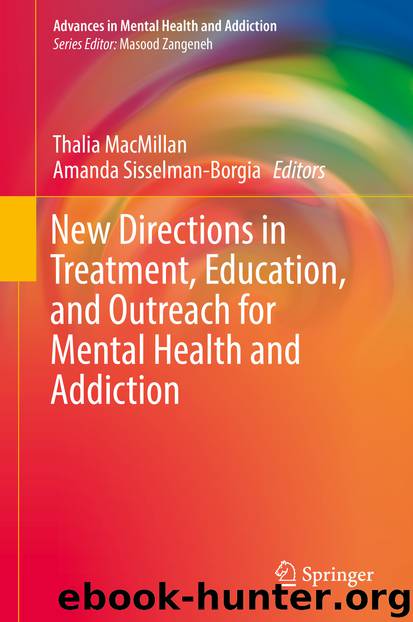New Directions in Treatment, Education, and Outreach for Mental Health and Addiction by Thalia MacMillan & Amanda Sisselman-Borgia

Author:Thalia MacMillan & Amanda Sisselman-Borgia
Language: eng
Format: epub
Publisher: Springer International Publishing, Cham
Attachment and Substance Misuse: A Theoretical Perspective
Attachment theory was initially developed by John Bowlby (1958), who became interested in the subject while working with children. Attachment behavior, according to Bowlby (1951, 1958), is an instinctive penchant to seek safety in proximity with a specific individual, the attachment figure (typically mother or primary caregiver), who is perceived to be protective. Bowlby (1951) posits that interactions of genetic, neurobiological, and developmental factors contribute to the regulation of stress resilience, anxiety sensitivity, and personality development. In addition, the primary caregiver’s ability to tune into (attunement) and reflect (mirroring) the emotional states of the infant are essential to the development of emotional capacity and competence (Bretherton, 1992). It is through these processes that the infant comes to understand the self as a separate entity with distinct feeling states and ultimately develops understanding of and empathy for the feelings of others. This is the groundwork for emotional self-regulation and identity. Incongruent mirroring leads to mistrust of one’s own emotional responses and the need to search the social environment for cues about how to think, feel, and act (Padykula & Conklin, 2010).
Substance use disorders can evolve from the attempt to regulate one’s attachment system in an effort to adapt (Padykula & Conklin, 2010). Individuals with substance use disorders suffer because they cannot or do not regulate their emotions, self-esteem, relationships, and behavior (Khantzian, 2012,). Self-regulation difficulties increase vulnerability to substance misuse. These individuals have great difficulty recognizing and tolerating feelings. This is due, in part, to fragile self-esteem and the absence of self-efficacy and competence (Graber, Turner, & Madill, 2016). Therefore, relationships with oneself and others are undeveloped or impaired by the lack of insight and skill necessary to sustain them. Substances become a means of avoidance and distraction. Or, they might provide a false sense of confidence often portrayed as bravado that further undermines relationships. Taking Khantzian’s thinking forward, it can be suggested that the substance of abuse becomes the substitute for relationship to oneself and others (Khantzian, 2012). Höfler and Kooyman (1996) argued that an individual might choose a substance as an attachment alternative to relationships. They linked this use of substances-as-relationships to attachment ruptures in childhood, manifesting during the life-transition stage in adolescence. “Because these individuals have an inability to recognize and regulate their own feelings and sense of self, they act as though they do not need close interpersonal relationships” (Khantzian, 2012, p. 112).
Flores (2006) suggests that individuals who struggle with developing intimacy and closeness with others may seek a method in which to self-soothe in times of distress. The relationship with substances can arguably become an attachment, which acts as both an obstacle to and a substitute for interpersonal relationships (Fletcher et al., 2015). A drug can create the feeling of having a secure base, and, within this framework, “addictive behaviors can be understood as misguided attempts at self-repair ” (Flores, 2006, p. 112). Substance abuse then becomes the solution, and the consequence of an individual’s impaired ability to develop and
Download
This site does not store any files on its server. We only index and link to content provided by other sites. Please contact the content providers to delete copyright contents if any and email us, we'll remove relevant links or contents immediately.
Cecilia; Or, Memoirs of an Heiress — Volume 1 by Fanny Burney(32437)
Cecilia; Or, Memoirs of an Heiress — Volume 2 by Fanny Burney(31873)
Cecilia; Or, Memoirs of an Heiress — Volume 3 by Fanny Burney(31857)
The Great Music City by Andrea Baker(31488)
We're Going to Need More Wine by Gabrielle Union(18972)
All the Missing Girls by Megan Miranda(15588)
Pimp by Iceberg Slim(14398)
Bombshells: Glamour Girls of a Lifetime by Sullivan Steve(13977)
Talking to Strangers by Malcolm Gladwell(13229)
Norse Mythology by Gaiman Neil(13211)
Fifty Shades Freed by E L James(13159)
For the Love of Europe by Rick Steves(13056)
Mindhunter: Inside the FBI's Elite Serial Crime Unit by John E. Douglas & Mark Olshaker(9206)
Crazy Rich Asians by Kevin Kwan(9170)
The Lost Art of Listening by Michael P. Nichols(7411)
Enlightenment Now: The Case for Reason, Science, Humanism, and Progress by Steven Pinker(7239)
The Four Agreements by Don Miguel Ruiz(6636)
Bad Blood by John Carreyrou(6558)
Weapons of Math Destruction by Cathy O'Neil(6148)
